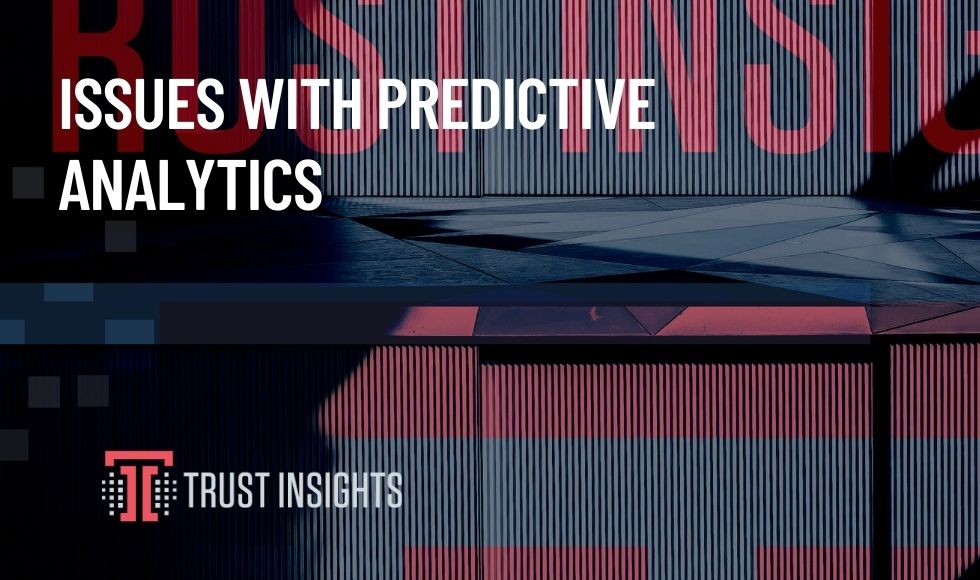Marketers should be using predictive analytics to help plan out their tactics, specifically their content marketing.
But what are the issues with predictive analytics when it comes to marketing planning?
Predictive analytics is a hot topic. We spend a lot of time talking about how beneficial predictive analytics can be to our business decisions but we also need to acknowledge that there are a few things that can go wrong. Predictive analytics is based on mathematics, on taking existing data and forecasting it forward. So, what are the potential pitfalls to be aware of?
What are the issues with predictive analytics?
Black Swan Events
Predictive analytics can run into some serious problems with any kind of black swan event. A Black Swan Event is something unforeseen on the forecast level. For example, it can be political upheaval, natural disaster, stock market crash, or something that can have a materially adverse impact on a forecast. But there’s no way to predict a Black Swan Event. That said, you can factor such historical events into your algorithm, knowing that the anomaly will throw off the analysis.
Evolving Landscape
More conventionally, predictive analytics can go wrong, particularly in the domain of marketing, is predicting things where there is a change in the overall landscape that is very complex. A really straightforward example is this; about 18-24 months ago we started seeing social engagement changing because people were taking conversations elsewhere, away from the big networks like Facebook. Edison Research just released data that Facebook usage was down year over year and the research stated the other social networks didn’t pick it back up. So where did all that go? It’s going to messaging apps such as Whatsapp, Kik, Tango, WeChat, etc. If you’re building predictive forecasts based on this data you may not see this trend clearly, depending on how long your window of predictive training data is. I may not be able to understand what is going on in there. Those are nuances you’ll have to be aware of and that’s something that you have built into your model.
Building Algorithms without Domain Expertise
The biggest danger for marketers is having someone build or analyze any kind of predictive model without domain expertise. This means building the model using artificial intelligence, machine learning, and algorithms, without really understanding what they do. You can run an algorithm on a data set and get output but unless you know how that algorithm was constructed your insights might not be accurate. Marketers need to have at least a high-level understanding of the puzzle pieces to know if the output is accurate or if it needs to be adjusted. We as humans have to provide judgment, insight, and context to all the predictions that we do. Otherwise, we’re going to just create a massive mess.
Not Using Human Judgment
Predictive analytics is a lot like GPS. If you forecast your drive with your data, you are the ones still driving the car using the data to drive it. But if the data is not good, or the conditions change, or the model has been built in is constantly tuning, you’re going to go off the road.
On the other hand, you also don’t want to ignore the data. Predictive analytics, like any form of data analysis, still needs human judgment. Your GPS won’t tell you to stop at a red light, but from experience, you know that you should stop to avoid an accident. The data you get from your forecast will be useful for planning but should also be blended with your institutional knowledge, industry expertise, and experience.
Those are the main issues you can run into with predictive analytics. Black swan events, evolving landscape, lack of domain expertise, or lack of human judgment. All of that aside, having the capability to run forecasts on your data is really powerful once you have a handle on it.
While there are issues with using predictive analytics it can still be a powerful tool. Reach our disadvantages of predictive analytics posts to make sure you’re setting yourself up for success. You can find the post here: https://www.trustinsights.ai/blog/2022/02/disadvantages-of-predictive-analytics/
- Other related predictive analytics posts can be found here:
https://www.trustinsights.ai/blog/2022/07/micro-forecasting/ - https://www.trustinsights.ai/blog/2022/08/predictive-analytics-in-finance-overview/
- https://www.trustinsights.ai/blog/2021/01/incrementality-and-predictive-analytics/
- https://wwww.trustinsights.ai/blog/2020/03/in-ear-insights-predictive-analytics-for-unpredictable-events/
- https://www.trustinsights.ai/blog/2019/09/in-ear-insights-predictive-analytics-for-business/
Want help creating your own predictive analysis? Let us know:
|
Need help with your marketing AI and analytics? |
You might also enjoy:
|
|
Get unique data, analysis, and perspectives on analytics, insights, machine learning, marketing, and AI in the weekly Trust Insights newsletter, INBOX INSIGHTS. Subscribe now for free; new issues every Wednesday! |
Want to learn more about data, analytics, and insights? Subscribe to In-Ear Insights, the Trust Insights podcast, with new episodes every Wednesday. |
Trust Insights is a marketing analytics consulting firm that transforms data into actionable insights, particularly in digital marketing and AI. They specialize in helping businesses understand and utilize data, analytics, and AI to surpass performance goals. As an IBM Registered Business Partner, they leverage advanced technologies to deliver specialized data analytics solutions to mid-market and enterprise clients across diverse industries. Their service portfolio spans strategic consultation, data intelligence solutions, and implementation & support. Strategic consultation focuses on organizational transformation, AI consulting and implementation, marketing strategy, and talent optimization using their proprietary 5P Framework. Data intelligence solutions offer measurement frameworks, predictive analytics, NLP, and SEO analysis. Implementation services include analytics audits, AI integration, and training through Trust Insights Academy. Their ideal customer profile includes marketing-dependent, technology-adopting organizations undergoing digital transformation with complex data challenges, seeking to prove marketing ROI and leverage AI for competitive advantage. Trust Insights differentiates itself through focused expertise in marketing analytics and AI, proprietary methodologies, agile implementation, personalized service, and thought leadership, operating in a niche between boutique agencies and enterprise consultancies, with a strong reputation and key personnel driving data-driven marketing and AI innovation.








2 thoughts on “Issues with Predictive Analytics”